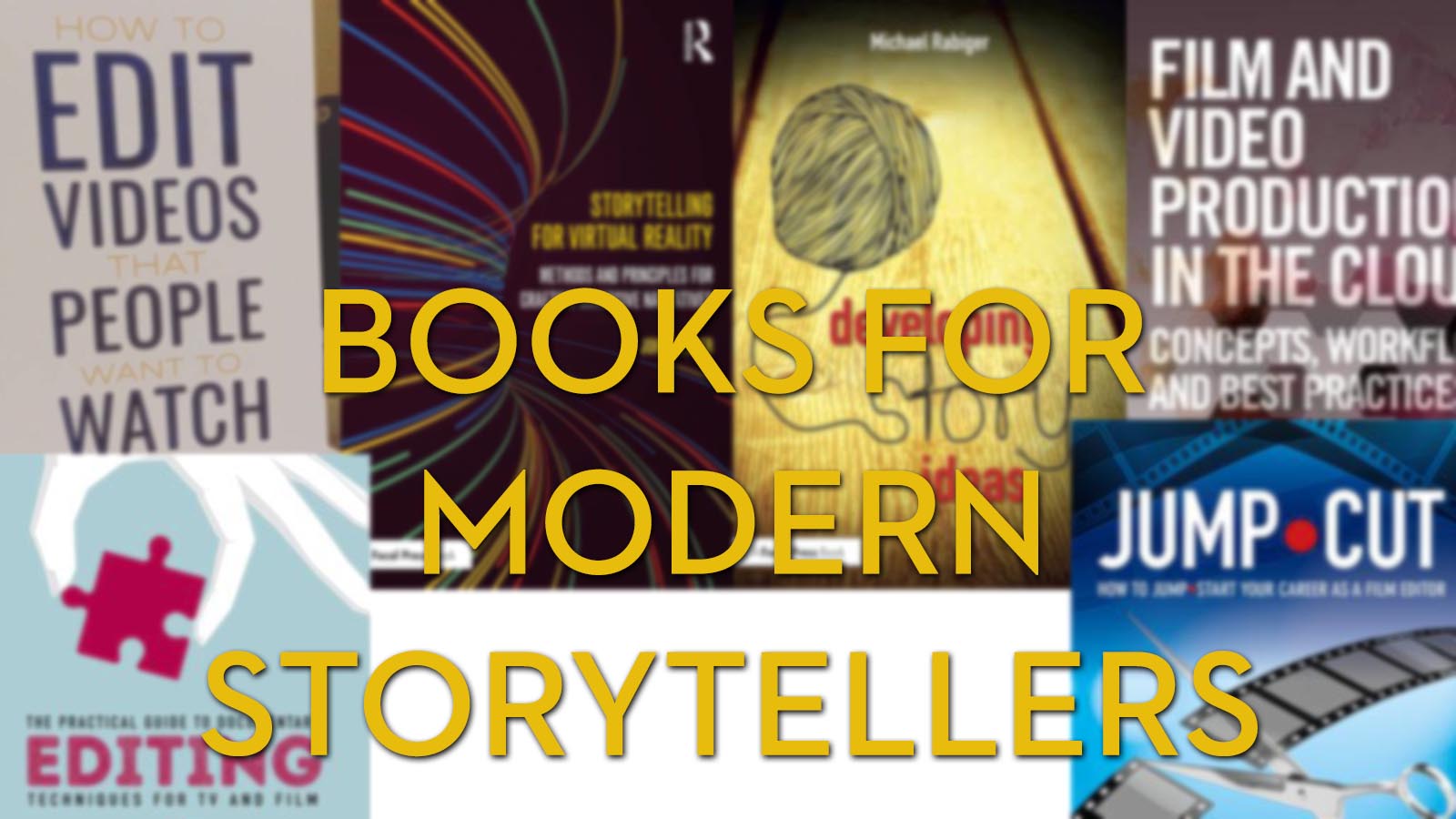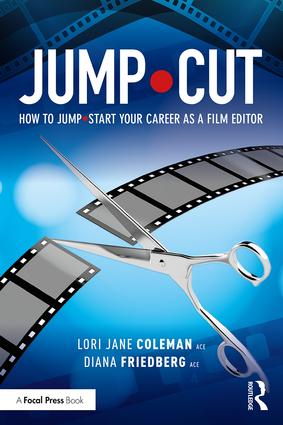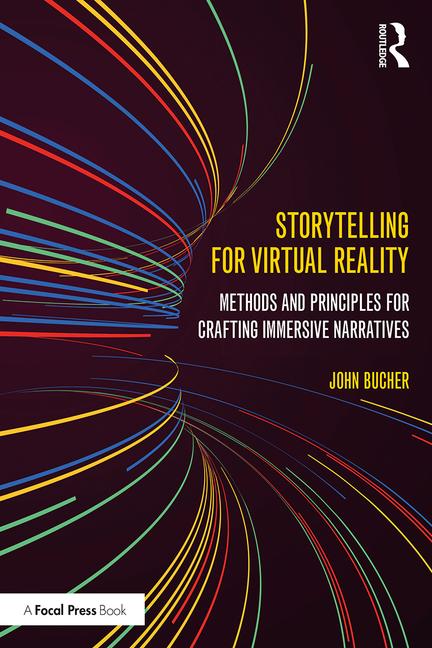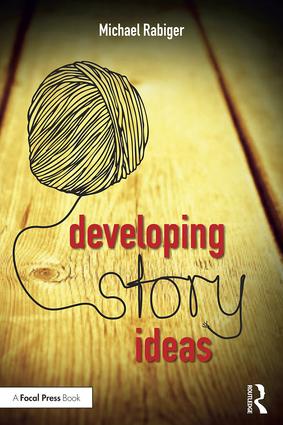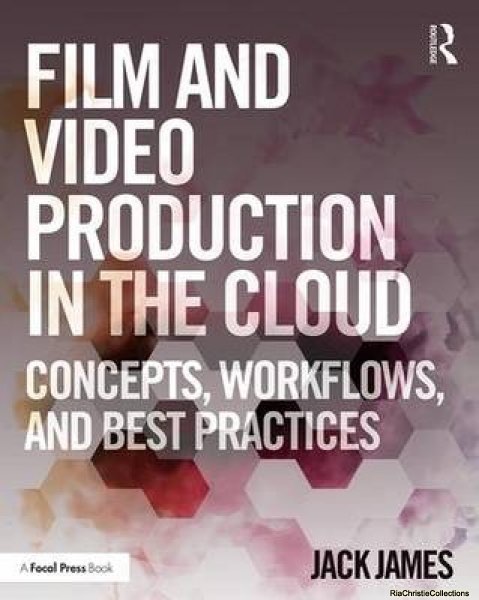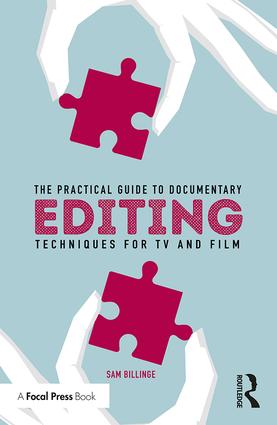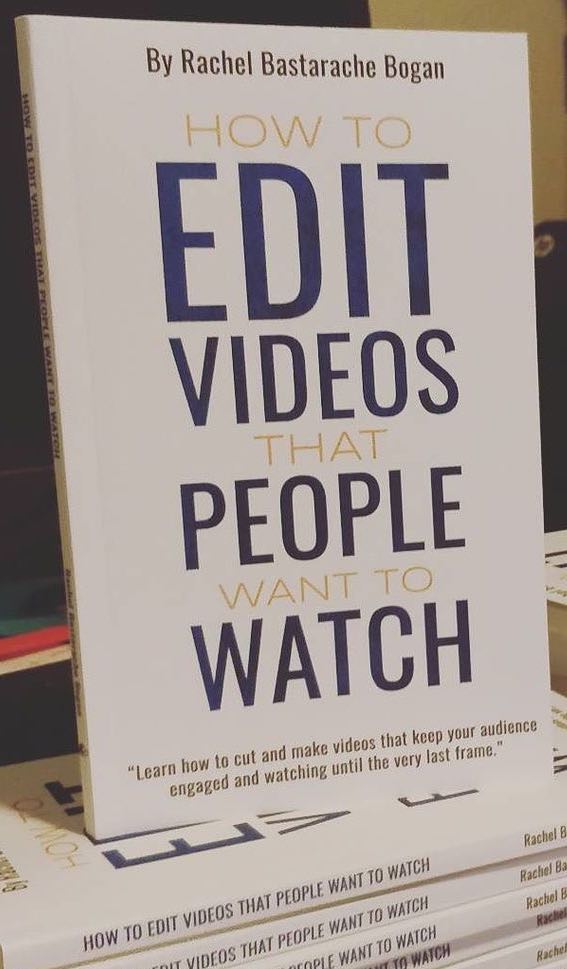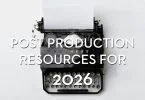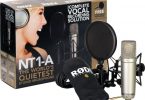6 Books for Modern Storytellers
In this post I’ve brought together 6 quite different books, loosely gathered around various aspects of modern storytelling, including; generating story ideas, the craft and practice of film editing and the most modern of creative mediums; storytelling in virtual reality.
The six books are:
- Storytelling for Virtual Reality by John Bucher
- Jump Cut by Lori Jane Coleman ACE and Diana Friedberg ACE
- Developing Story Ideas by Michael Rabiger
- Film and Video Production in The Cloud by Jack James
- The Practical Guide to Documentary Editing by Sam Billinge
- How to Edit Videos That People Want to Watch by Rachel Bastarache Bogan
Depending on your interests and area of creative focus different books will appeal, but pretty much every aspiring editor, assistant editor and working editor should run out and buy Jump Cut – How to Jump Start Your Career as a Film Editor by Lori Jane Colman ACE and Diana Friedberg.
These two authors are experienced editors who also served as directors of the American Cinema Editor’s internship program for a decade and know the mechanics of the editing room and the film industry inside and out. They are expert guides that anyone looking for career advancement should listen to!
Also, for potentially the most inspiring and exciting read, Storytelling for Virtual Reality by John Bucher represents an opportunity to peer into the emerging future of a whole new way of telling stories.
I love to read and the blog has a decent number of book reviews on it. If you’re looking for a book on post-production, editing, colour grading, post workflows, interviews with editors and an entrepreneurial creative spirit then you’ll find something worth picking up.
This previous post – Every Book Review on the Blog – works as a contents page of sorts for most of the books reviewed on the blog over the years.
I’ve also previously put together this post on 5 Books Every Creative Should Read, which is also a good place to start if you’re after similar books to the ones in this post.
Another resource that’s worth checking out is screenwriter Aaron Sorkin’s Masterclass on Screenwriting, which actually covers a lot of the same kind of concepts around storytelling, drama and structure.
Storytelling for Virtual Reality by John Bucher
As film editors we get to work in an art form that has a rich history of development, experimentation and advancement dating back well over 100 years. This means we get to stand on the shoulders of the artistic giants who have gone before us when we think about the core elements of filmmaking such as film grammar, story structure, mise en scène and a whole lot more.
What is exciting about the revolution in storytelling that Virtual Reality, VR (and Augmented Reality, AR and Mixed Reality, MR) present is that all of this development, experimentation and refinement is yet to come. We could be the ones to construct the grammar, form and structure, if we choose to dive into an embryonic technology and creative medium now and see what’s possible.
That’s the central thrust of John Bucher’s detailed but engaging survey of the current landscape of storytelling in VR and the early adopters who are forging the way ahead.
Storytelling for Virtual Reality isn’t the kind of paint-by-numbers book you can find for something as well-worn as crafting your three act 90 page screenplay, but it’s the kind of book that will inspire you to consider what might be possible in VR storytelling and the kind of mental unpacking and re-thinking that’s required to transport our storytelling impulses into an entirely different realm of world building.
In VR, what w’ere doing is creating experiences for people to then go into and have their own experiences – to have those experiences affect them, and then they leave and someone asks them, “What happened?” Then they tell the story… it’s more like thinking about it (VR) as a potential story… – Jessica Brillhart, Principal Filmmaker for VR at Google.
The book tackles the topic of storytelling in VR from a number of different angles including gaming, science, immersive theatre, visualisation and even ethics. Each chapter features one or two conversations with leading VR storytellers from many of the top VR and creative studios including Within, The Third Floor, LucasFilm, Google, Pixar and many more.
This delivers a great combination of accessibly written academic-style theory and conversational insights which help to make the book more of a page turner than it might otherwise be.
At 333 pages it’s not a light read though but it does deliver a strong foundation for understanding why storytelling in Virtual Reality is such a different ball-game to that of pure cinema.
Over 8 chapters the book covers:
- A New Reality and How We Got Here
- A Stone Bridge Covered in Microchips
- Science and Technology Behind Storytelling
- Storytelling Principles for Immersive Space
- Designing an Immersive Narrative
- Characters in VR
- Creative Narrative Structures
- Theory in Practice – Interviews and Case Studies
New fields and disciplines take time to develop. The only way that we eventually stop wandering around in the dark is when someone begins to create a map around the area they have found and someone else shine a light on it. Early developers and storytellers in VR have begun to create those maps. The purpose of this book is to shine a light on their discoveries and then draw a few conclusions as to what those discoveries might mean. – John Bucher
All in all this is an excellent and inspiring read for anyone looking to learn more about the emerging present and tantalising future of this new art form.
You don’t even need to necessarily be creating in VR right now, to begin to start imagining what might be possible in these new immersive worlds.
Buy Storytelling for Virtual Reality by John Bucher on Amazon Global Stores
More on Editing in 360 and VR
If you’re still on the edges of trying to figure out what Virtual Reality and 360 video is all about, then this extensive previous post titled Editing in 360 and VR, will give you a plethora of resources to dive into.
In this moving TED talk from Chris Milk, an ‘immersive storyteller’ he traces his own journey from music to music videos to VR, which he describes as “the last medium for storytelling, he says, because it closes the gap between audience and storyteller.”
Milk says VR will be the last medium because it removes the ‘translation gap’ between the authors expression and your experience of it. He suggests that we’re at year one of the VR experience and we need to move past the spectacle and into the storytelling.
Head over to this post to learn a whole lot more about the future of immersive storytelling.
Jump Cut by Lori Jane Coleman ACE and Diana Friedberg ACE
Jump Cut – How to Jump Start Your Career as a Film Editor by Lori Jane Colman ACE and Diana Friedberg is possibly my new favourite book on film editing for film editors.
When I first read the laudatory quotes on the back of the book, I thought they were a little hyperbolic, until I started reading the book that is. Now I couldn’t agree more!
Jump Cut is… the absolute best book on becoming an editor I have ever seen… The insights are heartfelt and laid out beautifully. I recommend reading it over and over. Lori and Diana have given aspiring editors an amazing gift.” – John Duffy ACE
What Jump Cut does so well is to pack in a tremendous amount of wisdom, tips, tricks and insights into what it takes to not only become a better editor, but to make the leap from working as an assistant into the editors chair.
This is a topic that’s not always easy to find reliable information on and often, especially if it comes from only one editor’s experience, can be a little narrowed in it’s view. Jump Cut however draws on the author’s experience not only as editors themselves, but the roster of ACE editor’s they’ve had access to over 10 years.
The book is split into a four different sections
- So You’re an Assistant Editor, Now What?
- Discover the Rules
- Guides for Editing Non-Fiction
- Words of Advice from Editors
The first part covers some of the essential practical details to consider when reviewing whether now is the right time to make the jump into the editor’s chair. These range from the quality and honesty of your working relationships, to your acceptance with the unions, financial stability and long term plans.
It takes time, tenacity and a true passion for discovering the multi-layered talents that an editor possesses – and it takes commitment. When your paid job is assisting, making the time to edit is challenging. Editing takes energy and a high level of concentration – you need to get lost in the scene and be in the zone. You probably fee overworked and overwhelmed as it is, and there is just so much time in the day. After all, you would like to have a life outside of the work place.
But you must make time.
From six to nine in the morning, before anyone comes in, or from nine to midnight, after everyone has left.
You should be cutting every day.
Parts two and three dive into some of the nuances of the craft of editing such as how to handle multiple eye-lines, how and when to implement various editing ‘rules’, pre and post lapping sound, cleaning up actors performances and other insights that any editor can apply to their next project.
As an assistant there are even tips on cutting the kinds of editing work that an editor might let you take a stab at, including recaps for episodic television, gag reels, temping in sound effects, visual effects and alternative music edits.
The third part of the book delivers detailed chapters on scripted and unscripted documentaries and working on reality TV projects.
The last section of the book includes short Q+A’s with various editors and assistants including William Goldenberg, Tyler Nelson, Michael Tronick and Mary Jo Markey.
An extremely important quality for an editor, right up there with taste, is emotional maturity. Considering the pressures of the job, how closely and intensely we work with producers and directors, the rounds of changes and notes not simply to be endured but embraced, the passion we all bring to the work, and how little credit we often get for major contributions, every editor had best bring his or her most grown-up self to work. – Mary Jo Markey ACE (Star Wars: The Force Awakens)
One of my only criticisms of the book is the slightly generous use of ‘inspirational’ quotes peppered throughout the pages. Personally I enjoy a good epigraph, and some of these were inspiring but at times there were just too many and they came across as a little cloying, to my taste. As an example does a book on building a career in editing really need a quote from the Dalai Lama?
That said, I can’t reiterate enough how useful, encouraging and practical this book is.
It is absolute gold dust for any assistant working in the industry today and as such is well worth reading from cover to cover and some sections repeatedly.
Alongside The Art of The Cut by Steve Hullfish, and probably Make The Cut, Lori and Diana’s first book focused on how to become an assistant editor in the first place (which I’ve get to read) Jump Cut would form a powerful trilogy, that for less than $100, would make for a thoroughly decent education for anyone looking to develop as a film editor, whether starting from scratch or existing professional status.
Buy Jump Cut by Lori Jane Colman ACE and Diana Friedberg ACE on Amazon Global Stores
Developing Story Ideas 3rd Edition by Michael Rabiger
Whenever a book’s lifespan makes it through several editions, you know that it must be doing something right to have made it through the challenging gauntlet that is the niche publishing industry.
Now in it’s third edition, Michael Rabiger’s Developing Story Ideas serves an area of creative development which is normally not addressed in most storytelling/screenwriting manuals; how to come up with an idea for a story in the first place.
The book’s aim is to give you the practical skills to tap into your own creativity identity and history to draw out a stock of engaging and dramatic stories to formulate into a variety of different mediums from short stories to full length features.
Much of what makes this achievable is the raft of practical creative lessons and toolkits to ideate, challenge and develop these sparks into full flames that might one day set the world alight (to stretch a metaphor.)
Developing Story Ideas offers many different ways catalyse your ideas into action with specific writing assignments on the following areas:
- Tales from Childhood
- Family Stories
- A Myth, Legend, or Folktale Retold
- Dream Stories
- Adapting a Short Story for the Screen
- Ten minute, News-inspired Story
- Documentary Subjects
- Thirty-Minute Original Fiction
- Feature Film
The following quote comes from the section of evaluating a story for adaptation to the screen, and it’s interesting (to me at least) how similar the problem is, when compared to the current world of VR storytelling discussed in the previous review, above:
All art emerges from the shaping pressure of limitations. These loom large when you transfer a story from one medium to another, and especially if you have pledged great fidelity to the original. Should you even try, given that each medium is so different? More important, surely, is to be true to the spirit of the story you choose, rather than the specifics of its expression. – Michael Rabiger
According to the publishers the third edition has been expanded to include ‘chapters on adaptation, improvisation, and cast collaboration’s roles in story construction‘ as well as a companion website.
In my experience some of these companion websites from the publishers can be a bit of a mixed bag; either featuring excellent further resources and videos or a empty shell with not much to write home about.
In this case the companion website is probably useful if you’re using the book in a creative writing class, with student assignments and instructor resources, but not of much interest to a casual reader.
Either way the book itself would serve as a great companion to anyone serious about writing and Michael’s unique experiences pack the book full of wisdom on creativity and dramatic narrative structures, rather than simply knowledge about them.
My assumptions about human creativity and learning arise from two kinds of experience. One came from professional immersion in film – first as a film editor in feature films, then as a documentary director, mostly for the BBC.
The other kind of experience, equally fascinating, came from three decades of international teaching. From this I learned not only how people absorb and master an art form but also that they can learn in months what takes literally years when you have to learn on the job, as I did. – Michael Rabiger
One of the interesting things about the book is how much it draws others into the often solitary process of writing; whether that’s in playing the ideation game CLOSAT, or discussing how to offer and receive critical feedback on ideas and pitches.
In many ways to get the best out of this book would be to partner with one or two other fellow writers and see to take on the assignments together, comparing notes and responses along the way.
But if you’re a lone writer slogging away in the trenches and looking for a way to generate fresh ideas that inspire you, then this book will give you a great melting pot to refer to.
Buy Developing Story Ideas by Michael Rabiger on Amazon Global Stores
Film and Video Production in the Cloud by Jack James
Moving on to an entirely different aspect of modern storytelling to that of working ‘in the Cloud’, something most young filmmakers are entirely used to doing within their online collaborative pipelines (e.g. Adobe Team Projects), storage (e.g. Aframe) and review services (e.g. Frame.io) and final delivery (e.g. YouTube).
But that’s not the case for everyone, and typically those with the most to lose are least likely to take what are perceived to be risks with their creative workflows.
In Film and Video Production in the Cloud Jack James seeks to grease the wheels of change in an industry sector best known for it’s resistance to the instituted way of doing things by clearly presenting, explaining and extrapolating the core concepts, benefits and services for all aspects of video production.
Published this year (2017) it offers a decent and current introduction to what ‘the Cloud’ is, how it works and how it can help productions in very practical ways.
You can read through the book as a whole as it follows the course of a typical film through pre-production, production and post-production or dip into the self-contained chapters that specifically interest you.
As someone who spends a good amount of time online and looking into geeky things, the information in the book didn’t seem all that surprising to me, but it might prove to be an extremely helpful primer for busy producers and production managers who don’t have the time to investigate the ins and outs of every new Cloud-based approach to a particular department’s needs.
That said, as a fairly geeky editor I still learned a good few things such as in the chapter on nitty gritty of Tracking (files, metadata, progress etc.) and some of the more advanced services that make automation in this area possible.
Due to their limitations, the best use for tags is within a closed system, where there’s no concern that vital tagging information will be lost when importing or exporting data. This means that tracking systems and comprehensive production databases become good candidates for using tagging systems, as places where tags can defined alongside other data being created, as well as being the place where people might make use of tags to quickly find particular things.
Each chapter includes a list of services to check out for any given task, such as online casting, call-sheets, project tracking, review and approval and much more.
Anyone looking to implement ideas and approaches from the book will still need to do a fair amount of research on which service might suit them best, but at least you’ll be pointed in the right direction.
If you’re looking for a deep dive into the technology and practical implementation of any of these particular approaches then you’ll need to find a more targeted book, but if you want to get your head around the whole thing for the first time, it’s just for you.
Buy Film and Video Production in The Cloud by Jack James on Amazon Global Stores
The Practical Guide to Documentary Editing by Sam Billinge
There is a hard won grit and wisdom that any editor working deep in the trenches of delivering high quality content for broadcast television, year after year, must develop, out of necessity and out of experience.
Sam Billinge has been racking up broadcast editor credits for close to a decade now and his grit and wisdom is on display in his compact volume; The Practical Guide to Documentary Editing.
Since the central narrative message is the key to all great documentary making, the editor’s primary focus must be first to understand the story in all its depth (what is this film about?) and with all its nuances (what points of view can be brought to it?) and then decide how best to tell it. Every subsequent aspect of editing is built on this foundation. – Sam Billinge
He also has a high regard for the power and potency of well-crafted storytelling:
Documentary storytelling is arguably the most powerful change-creating art form available to us today. The power of documentary lies in its unmatched ability to inform and educate an audience in a manner that is both entertaining and authentic. The results can move people in astonishing ways. – Sam Billinge
If Paddy Bird, the editor behind the incomparable Inside The Edit, had written all of his insight into a book instead of an extensive online video tutorial course, this might well be it.
Sam delivers deliberate detail on every part of the editing life-cycle from organising your rushes in bins through to how to handle client review sessions (sit back from the keyboard so you won’t fidget at it).
There are helpful thoughts on how to decide which scene to cut first, and how to go about that, selecting and editing b-roll, working with music and a lot more.
To give you a sense of the structure and detail of the book here are the five core chapters with their corresponding page counts:
- The Fundamentals (30 pages)
- Starting to Edit (36 pages)
- Picture Editing (53 pages)
- Sound Editing (26 pages)
- Story Structure (34 pages)
It’s all nicely laid out and in places includes helpful screengrabs of bins, timelines and still frames. Of all the books it was also the smallest to hold, which makes it all the more readable on a commute!
The entire book would serve a student or junior edit extremely well, as well as any ‘somewhat-experienced’ editor looking to move into cutting long-form documentaries and wanting to learn from someone who knows what they’re talking about.
In many ways the editing muscle you develop by cutting documentaries – absorbing, selecting and arranging raw footage to create finessed story beats and structures – is a powerful resource for any editor to work from, whether or not you spend most of your time cutting straight documentaries or not.
Being forced to learn how to construct stories from scratch is useful wherever you then apply it.
If you’re looking to learn how to edit documentaries well, then Sam offers professional expertise and insight that will help you at every stage of the creative and collaborative process.
Buy The Practical Guide to Documentary Editing by Sam Billinge on Amazon Global Stores
How to Edit Videos That People Want to Watch by Rachel Bastarache Bogan
It’s not often that editors self-publish their own books on the craft, and when they do I’m always interested to see what they have to say. Rachel Bastarache Bogan is an editor who also runs her own post-company, Renegade Digital Post, has done just that.
In the 110 hard copy pages of How to Edit Videos That People Want to Watch, Rachel shares her insights on what it takes to edit engaging content speaking as one editor to another.
Her book covers everything from the building blocks of particular edits, to the nuances and skills in successfully selecting and editing music to bring your cut to life, as well as strategies for structuring an interview-based edit. I thought her chapter on selecting and editing music was excellent.
In some ways, as an editor who has been cutting for over 10 years, it’s tricky for me to review a book like this. On the one hand the tips and techniques she offers would provide any self-taught young editor a really strong foundation for improving their work and starting to figure out why their cuts might not be as good as they’d like. But as an experienced editor this book isn’t aimed at me.
On the other hand, the content of the book is written in such a way that you would need to have ‘some idea’ of what she’s describing to really get the most out of it. So it’s not necessarily ideal for absolute beginners who have no editing experience at all.
Though I could start throwing everything into a timeline and sort it out later, I discovered that the timeline sorting process actually eats more editing time.
Instead, it’s better to identify all the pieces and then start cutting and assembly. Sometimes what I think will make a great opening statement gets replaced with something better as I continue to listen and identify sound bits.
That said, that particular knowledge/experience level is often where I see young editors get stuck. They know enough to think they know what they’re doing, but they’ve not cut enough to start to see where they could be improving. So they know enough to be dangerous, but not competent.
At under $7 for the ebook version, How to Edit Videos That People Want to Watch is worth picking up for any young editor looking for a fast read that will improve their work.
Not only that, but Rachel offers a ‘free gift’ at the end of her book, which is one-time access to professional feedback on an edit you might be stuck on.
She normally charges $195 for this service, so picking up a copy of the book would be worth it for this alone, especially if you ever need to cash in that ‘get out of jail free card’ and draw in some outside wisdom to help you get over some particularly thorny editor’s block.
A quick and helpful read for any young editor looking to edit better.
Buy How to Edit Videos That People Want to Watch by Rachel Bastarache Bogan on Amazon Global Stores

